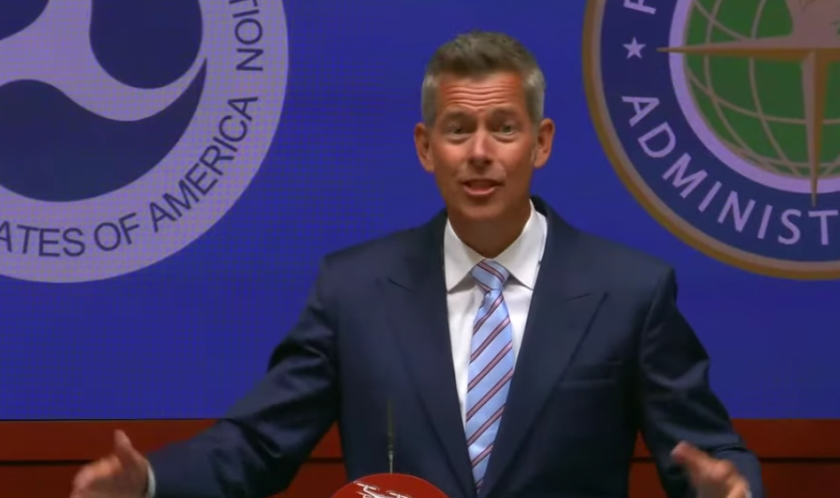US Transportation Secretary Sean Duffy has today announced a new rule to normalise commercial beyond visual line of sight (BVLOS) operations, eliminating the process for individual waivers.
“The rules will be done in a completely different way,” Duffy said at a press conference, adding that the new rules will enhance safety by requiring safe separation from other unmanned aircraft. “This has been a long time coming. We are not afraid to move and move fast, and move safely”.
The proposal includes updated requirements for manufacturers, operators, and drone traffic-management services to keep BVLOS drones safely separated from each other and from manned aircraft.
The Federal Aviation Administration (FAA) proposed rule for safely normalising Beyond Visual Line of Sight (BVLOS) drone operations includes detailed requirements for operations, aircraft manufacturing, keeping drones safely separated from other aircraft, operational authorisations and responsibility, security, information reporting and record keeping.
Operations would include package delivery, agriculture, aerial surveying, civic interest – including public safety, recreation and flight testing. They would occur at or below 400 feet above ground level, from pre-designated and access-controlled locations. All operators would need FAA approval for the area where they intend to fly. They would identify the boundaries and the approximate number of daily operations, as well as takeoff, landing and loading areas. They would ensure adequate communications coverage and procedures in cases where the communications with the drone are lost. Operators would have to be familiar with airspace and flight restrictions along their intended route of flight including reviewing Notices to Airmen (NOTAMs). Operators would also be required to identify and mitigate any hazards. The FAA would evaluate proposals to fly multiple drones on a case-by-case basis.
Regarding safe separation, operators would use Automated Data Service Providers (ADSPs) to support scalable BVLOS operations. These ADSPs could provide services to keep BVLOS drones safely separated from each other and manned aircraft. The FAA would approve and regulate these entities and require the services to conform to industry consensus standards following vetting and testing. Under the proposed rulemaking, a BVLOS operator could be its own data service provider or contract with another company.
The FAA is proposing two types of authorizations for BVLOS operations, depending on the scope. Lower-risk operations that have limited fleet size, weight, and operational scope would require an FAA permit. The FAA says it could issue these promptly. Types of permitted operations include package delivery, agricultural, aerial surveying, civic interest, unmanned aircraft operations training, flight testing, demonstrations and recreational operations. Meanwhile, higher-risk operations due to aircraft size, weight, speed or fleet size would require an operating certificate. The FAA would conduct thorough reviews of the proposed operations before issuing a certificate, provide more oversight of the operator and operations, and require operators to develop a safety management system (SMS) and training programme.
The FAA proposes to require two positions: operations supervisor and flight coordinator. The operations supervisor would be responsible for overall safety and security. This would include ensuring operations meet all regulatory requirements and operating limitations that apply to the aircraft, and ensuring all personnel are properly trained and knowledgeable. Flight coordinators would directly oversee aircraft operations and intervene to ensure safe conditions, if necessary. Neither position would require holding an FAAissued airman or remote pilot certificate.
The proposed ruling would allow operations over people but not over large, open-air gatherings such as concerts, sporting events or crowded parks.The FAA proposes five categories of operations over people based on population density, and each density would have operational restrictions. The restrictions, technological and operational mitigations would increase with the population density.
Operators would be required to report specific information to the FAA, such as flight data and unplanned landings. They would also be required to keep records including flight details, maintenance and training, whereas ADSPs would be required to keep records of compliance and test data and software provisions.
Drones also would have technologies that enable them to automatically detect and avoid other cooperating aircraft, and they would yield to all manned aircraft broadcasting their position using ADS-B. Drones could not interfere with operations and traffic patterns at airports, heliports, seaplane bases, space launch and reentry sites or facilities where electric Vertical Takeoff and Landing (eVTOL) aircraft take off or land. Among other product-specific measures, the rule would require drones operated under Part 108 to have lighting and to broadcast Remote ID.
Security and cybersecurity are covered in the proposed rule. For example, the Transportation Security Administration would require operations supervisors, flight coordinators, and other covered personnel to obtain up to a level 3 security threat assessment that may include a watchlist check, immigration check and a fingerprint-based criminal history records check.
“We are partnering with the Transportation Security Administration to ensure that operators and coordinators are properly vetted,” Duffy said.
At the press conference, Duffy handed over to FAA Administrator Bryan Bedford who said current drone operations in the United States are perhaps not as regulated as they should be, which makes it difficult to manage and makes for an uneven playing field. “We are confident that we have the technology that will allow drones to see and avoid manned aircraft in the national airspace service,” Bedford said.
Also present at the press conference, Lisa Ellman of the Commercial Drone Alliance said while the industry has had the technology, regulatory frameworks in the United States have failed to take place, as other countries surge ahead. “Today’s proposal provides certainty about what business success will look like in this new era; investors can now see proof that the government supports the use of this critical technology.”
Heather Lee of AUVSI said today’s draft rule is a “breathtaking moment”. “This rule will enable the scaling of critical applications. Today signals a powerful commitment to safety, innovation and American drone dominance.”
The following 60 days of the rulemaking process will take into consideration stakeholder comments.
For more information




